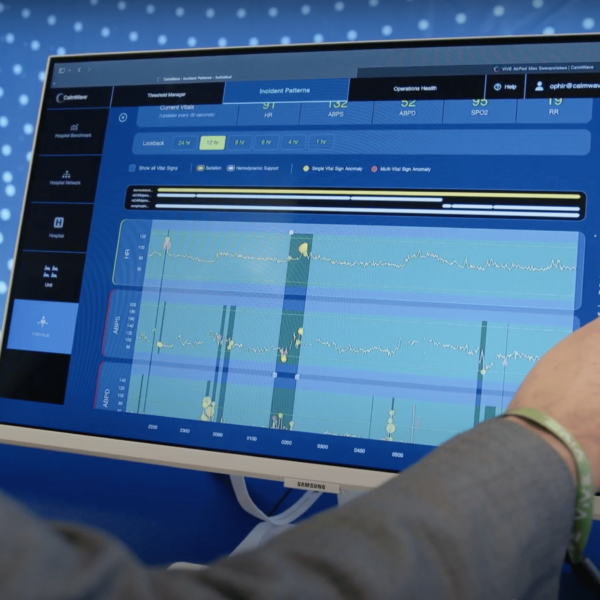“Very few products create safety and reduce work. CalmWave does both.”
— Dr. Pranav Jain, Chief Health Information Officer, Wellstar Health System
— Dr. Pranav Jain, Chief Health Information Officer, Wellstar Health System

Hospitals have long faced a critical paradox: the very alarms designed to save lives are overwhelming clinicians, delaying care, and accelerating burnout. Alarm fatigue isn’t a minor inconvenience – it’s a Joint Commission–recognized patient safety risk and a leading cause of global nurse attrition.
No solution had ever meaningfully addressed the root cause: a flood of non-actionable alarms that obscure true clinical emergencies.
Wellstar, one of the Southeast’s largest health systems, partnered with CalmWave to do what no one else has done: tackle the alarm fatigue crisis at its core. In a global first, Wellstar Kennestone’s CCU deployed CalmWave – and the results were transformative.

There was no need for new hardware or added headcount. CalmWave was deployed in less than two months, allowing nurses to refocus attention on care, rather than constant noise triage.
For the first time, alarms no longer drowned out what mattered most – patients.
Alarm fatigue is just the beginning. By aligning alarm management with staffing realities, clinical acuity, and device-level visibility, CalmWave is redefining what modern hospital operations can actually look like. It reshapes day-to-day care into a calmer, smarter system. This is the future of scalable, patient-centered healthcare.
And your hospital can be next.
Because now, alarm fatigue is finally being addressed with real results.
— CCU Nurse Leader, Wellstar Kennestone
Critical Care has become the noisiest – and most high-risk – unit in the hospital.
In a typical ICU, a single patient can trigger an average of 771 alarms every day. Multiply that across the unit and it’s a tidal wave: thousands of beeps, every shift, every day. Up to 99% of these alarms don’t require action, yet overall they disrupt focus and drain critical attention. It’s not just noise – it’s clinical misdirection that compromises response time and safety.
Nurses spend up to 35% of their shift managing alarms, diverting time away from direct patient care. They silence alarms, acknowledge alerts, and sift through relentless noise. Meanwhile, real physiological alarms get buried. 81% of nurses report alarm fatigue. The consequences are clear: rising burnout, increased attrition, and higher patient risk.
— Ryan Sanders, AVP Biomedical Engineering, Wellstar Health System
This constant flood of alerts doesn’t just exhaust nurses, it desensitizes care teams, conditioning them to overlook the very signals they’re trained to act on. When real emergencies are lost in the noise, patients experience the consequences.
Alarm fatigue has been tied to adverse events, including patient deaths, and remains a top safety concern identified by The Joint Commission. While hospitals recognize the risk of alarm fatigue and national policies are in place, most solutions have been superficial: redirecting alerts to pagers, adjusting alarm tones, or implementing limited training programs. This challenge is baked into the system – not the people.
Alarm thresholds are rarely changed from the factory defaults – even as patient conditions shift significantly. Modifying these settings often requires a physician order, introducing delays, friction, and clinical risk. There’s no clear signal. No single source of truth to distinguish which alarms are actionable and why. Clinicians are left to react without the appropriate data, while overwhelmed by constant interruptions.
— Dr. Pranav Jain, Chief Health Information Officer, Wellstar Health System
Traditional alarm management has relied on one-size-fits-all solutions – applied to highly individualized patient needs. The result is a perfect storm of over-monitoring, under-response, and clinician overload.
After decades of limited progress, Wellstar demonstrated what meaningful impact can look like.
What if alarm fatigue wasn’t just a part of the job, but a challenge waiting for the right solution?
At Wellstar Kennestone, CalmWave proved that the crisis wasn’t driven by clinician error or faulty devices. The real culprits? Fragmented data, outdated thresholds, and systems unable to provide a complete, contextual view. Together, CalmWave and Wellstar partnered to set a new standard.
— Dr. Pranav Jain, Chief Health Information Officer, Wellstar
CalmWave’s Transparent AI unified live data from Philips IntelliBridge and Epic – systems that had traditionally operated in silos. Through its proprietary Common Signal Format (CWC), CalmWave streamlined fragmented noise into a single, actionable signal.
For the first time, every team – nurses, clinical engineering, physicians, leadership – was aligned around a unified intelligence. Clinicians received patient-specific recommendations, clinical engineering teams monitored device performance from one screen, and leadership viewed system-wide trends—all powered by a single source of truth.
— John D. Cooper, VP of Venture Investment, Catalyst by Wellstar
CalmWave began by mass optimizing alarm defaults across the entire unit, then delivered customized CalmWave Optimized™ recommendations tailored to each patient as their condition evolved. Eliminating guesswork, CalmWave integrated medication data and vital signs in real time, offering clinicians a level of insight not available through the EHR alone.
Clinical engineering teams no longer had to wait for an issue to arise. CalmWave proactively identified issues by room, patient, and failure type before a single ticket was filed.
— Ryan Sanders, AVP Biomedical Engineering, Wellstar Health System
CalmWave delivered more than metrics, it redefined how care teams respond, prioritize, and protect patients. What started as a pilot is now the operational standard – achieved seamlessly within existing systems.

— John D. Cooper, Catalyst by Wellstar
One unit showed what’s possible. The impact reached from bedside to boardroom, uniting teams around a shared language of safety, clarity, and signal over noise.
Now, Wellstar is mobilizing and clinicians are asking when CalmWave will reach their floor. This new standard of care isn’t isolated — it’s scalable and in demand.
— Dr. Lori Westphal, Innovation Manager, Catalyst by Wellstar

For decades, alarm fatigue has jeopardized patient safety and pushed clinicians to the brink. Now there’s a proven, production-ready solution that protects both.
The Calm ICU™ is a signal-led critical care environment—powered by CalmWave—where non-actionable noise is cut and clinical urgency breaks through. It’s how hospitals align teams, technology, and time to accelerate decisions where they matter most: at the bedside.
Whether you lead a single ICU or a national system, CalmWave can empower your teams to focus, your patients heal, and your operation as a whole to perform at their best.
Let’s make alarm fatigue obsolete.
Want to see how it works? Request a demo (right) or reach out at info@calmwave.ai.